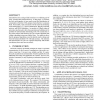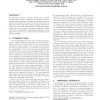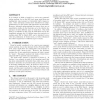CEAS
2007
Springer
14 years 6 months ago
2007
Springer
To evade blacklisting, the vast majority of spam email is sent from exploited MTAs (i.e., botnets) and with forged “From” addresses. In response, the anti-spam community has d...
CEAS
2007
Springer
14 years 6 months ago
2007
Springer
Email has become an integral and sometimes overwhelming part of users’ personal and professional lives. In this paper, we measure the flow and frequency of user email toward th...
CEAS
2007
Springer
14 years 6 months ago
2007
Springer
Near-duplicate detection is not only an important pre and post processing task in Information Retrieval but also an effective spam-detection technique. Among different approache...
CEAS
2007
Springer
14 years 6 months ago
2007
Springer
Many of the first successful applications of statistical learning to anti-spam filtering were personalized classifiers that were trained on an individual user’s spam and ham ...
CEAS
2007
Springer
14 years 6 months ago
2007
Springer
Web spam research has been hampered by a lack of statistically significant collections. In this paper, we perform the first large-scale characterization of web spam using conten...
CEAS
2007
Springer
14 years 6 months ago
2007
Springer
We show how a game-theoretic model of spam e-mailing, which we had introduced in previous work, can be extended to include the possibility of employing Human Interactive Proofs (h...
CEAS
2007
Springer
14 years 6 months ago
2007
Springer
We address the problem of filtering image spam, a rapidly spreading kind of spam in which the text message is embedded into attached images to defeat spam filtering techniques b...
CEAS
2007
Springer
14 years 6 months ago
2007
Springer
CEAS
2007
Springer
14 years 6 months ago
2007
Springer
CEAS
2007
Springer
14 years 6 months ago
2007
Springer




